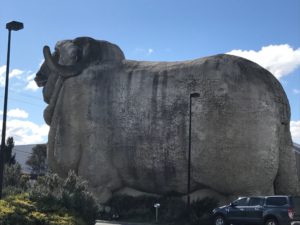
I had just finished running one of my attitudinal and behavioural safety team sessions, and was fuelling up with coffee and petrol before embarking on my trip home. I’d been at the same cafe twice before, but it was only this time that I actually saw the sheep. A huge, massive concrete sheep, which has probably been used as a landmark in countless requests for directions, undoubtedly accompanied by the line ‘you can’t miss it.’
Yet I did miss it. The 15.2 metre Big Merino.
And I had just been talking about how to tune in to our focus and attention so as to not miss hazards or avoid risks. Oh the irony.
Blind spots are part of our unconscious filtering system. Sometimes we just don’t see stuff. And that stuff can be really, ridiculously obvious.
If you ever wonder why your boss or team mate can’t see how their behaviour affects others, or how their communication style isn’t working, or how their performance is being compromised by certain actions or lack thereof, it could be a blind spot. And if it is, then chances are they won’t see it until someone helps them to see a better way. And that someone could be you. As long as we keep assuming that they know, nothing will change.
If it’s that easy to miss a giant sheep, how easy is it to miss subtle nuances that make a massive difference to our work culture – a lack of presence potentially creating a lack of connection, a lack of awareness that can unintentionally lead to low trust levels, or a lack of insight creating a skewed perception.
We need to create a culture where it’s ok to speak up and speak out, where it’s psychologically safe to enlighten each other and consequently where everyone will remind each other to take notice of the sheep.
